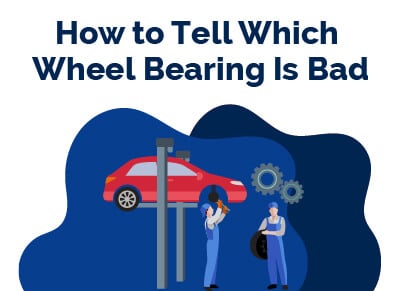How to Tell Which Wheel Bearing Is Bad
August 24, 2022


I am a serial entrepreneur and a consumer advocate. When I’m not helping car buyers, I love working on ventures that have a positive impact.
I run a cause marketing agency and serve on the board of Vayu Global Health where we are disrupting the medical industry and preventing the needless deaths of mothers and babies during childbirth.
Each of your tires has its set of wheel bearings, and the damage across these bearings is not always the same on each tire. A bad wheel bearing can cause poor rotation of your wheels or influence noticeable differences in your driving behavior.
You need to know which wheel bearing is bad, front or back. But, how do you find out which wheel bearing has gone?
To tell which wheel bearing is bad, you must jack up your car and test your wheels for noise, roughness, and stiffness. Rocking your wheels back and forth helps you know the state of your wheel’s bearings.
Let’s discuss how to tell which wheel bearing is bad: front or back!
Table of Contents
How To Tell Which Wheel Bearing Is Bad, Front or Back
1. Wheel Bearing Noise Diagnosis
The first way to tell which of your wheel bearings is bad is by conducting a wheel bearing noise diagnosis. Bad wheel bearings produce awful noise when the tire moves or when you rotate them.
The noise will get louder as you accelerate or roll the wheels aggressively. You have to test each car wheel to determine which has a bad bearing.
A bad tire also produces an annoying noise as you drive. This might make it confusing to determine if you have bad tires or a bad wheel bearing.
It is simple. To conduct a wheel bearing noise diagnosis, you have to do the following:
- Jack up the car.
- Grab the tire and spin.
- You have to check out for howling or grinding noises.
- Repeat the process for each wheel and observe which produces noises when you spin.
A bad wheel bearing will produce loud grinding or howling noise when you rotate the wheels and clunk sounds when you take turns. Worn bearings cause these noises.
The back and front bearings produce the same sounds when they are bad. It would help if you focused on the area where the sounds are coming from.
2. Wobbly Wheels
You can determine which wheel bearings are bad by observing which wheel wobbles. The wheel bearings connect your wheels to the axle, reduce frictional impacts and ensure smooth rotation.
When the bearings are bad, the wheels wobble, and you experience excessive play. This is because the wheels are loose.
The loose wheels will not only wobble but can cause vibration on your steering wheels. This will affect your safety and driving performance.
While your car is still jacked up, hold the wheel from top to bottom and shake. You can repeat this by holding the wheel side by side. You must carry out this process on all wheels.
You can tell if the front or back wheel bearings are bad from the position of the wheels that wobble.
3. Tire Wear Condition
The tire condition and worn-out area are easy ways to tell which wheel bearings are bad. The wobbling wheels will cause uneven tire wear.
This is an easy way to tell which wheel bearings are bad. You should check the tires with inconsistent wear conditions. They are likely the ones with a bad wheel bearing.
4. Vehicle Pulling Toward One Side When Braking
Bad wheel bearings make your vehicle pull toward one side when you hit the brakes. The position the car pulls toward should help you figure out if the front or back bearings are bad.
The car will pull to the right if the front-right bearings are bad, and it will pull to the left if the left-back bearings are bad.
For instance, if your rear left wheel bearings are bad, your car will wobble in different directions while pulling to the left side of the road. This can go as far as giving you the impression that you are losing grip on your tires.
However, other factors can cause your car to pull to one side. These factors include uneven tire pressure, bad wheel alignment, brake failure, or suspension and steering system issues.
You might need a technician to diagnose your car to decide if the fault is properly from the bearing.
5. Rough and Rigid Wheels
A good wheel bearing makes it easy to spin your tire wheels smoothly. To tell which wheel bearings are bad, rotate your tires, one at a time.
If you notice a rough and rigid wheel feel in any of your wheels, you should check the bearings.
How Do You Check Front And Rear Wheel Bearings?
- Take the car for a ride and check for noise and humming sounds.
- Jack the front and rear wheels up. If you notice howling, humming, or strange noises from your car, jack up the front and rear wheels and test them. The manufacturer’s manual might guide you on jacking up the wheels.
- Hold the wheels in opposite directions and shake. The wheel that wobbles or experiences some play has a bad bearing. You should tell if this happens with the front or rear wheels.
- With your car suspended in the air, you might have to turn on your engine.
You may need an experienced technician to help you with this to avoid ramming your car into your sitting room. For safety, disable the entire system if your vehicle has traction control. You can do this by pulling the ABS fuse under the hood.
Run your tires in the air by accelerating the engine. Diagnose the wheels individually by blocking other wheels with a stone.
As the wheels rotate, look closely for vibrations. If the front tires shake while spinning, you have a bad front wheel bearing. You can increase the acceleration and listen for increased noise.
Common Bad Wheel Bearing Symptoms
- Wheel vibration while driving and braking.
- Unusual noise (knocking, howling, and grinding noise).
- “Clicking” noises when taking turns.
- Rough rides.
- Uneven wearing of tires.
- Vehicle pulling to one side.
- Wobbly wheels and excessive freeplay.
- ABS light comes on.
Why Do My Wheel Bearings Keep Going Bad?
Here are four major factors that make your wheel bearings keep going bad.
1. Driving Conditions
Your wheel bearings will keep going bad if you are fond of driving through water or mud. Driving through dusty areas and frequent contact with road salt will also negatively impact your bearings.
They will pollute the grease and cause the bearings to rust or wear quickly. Overloads place much weight on your wheel bearings, and this causes them to wear out quickly.
2. Road Conditions
If you are constantly bumping through potholes and bad roads, you don’t need to be surprised that your wheel bearings are also going bad.
Driving through bad roads puts a lot of stress and strain on your wheel bearings. Road contaminants can also damage your bearing or clog the lubricant, causing an excessive frictional effect on the bearings.
3. Wrong Installation
Improper installation of the bearings can cause your wheel bearings to keep failing. You must maintain precise accuracy while installing your bearings.
Do not use excessive force to install your wheel bearing. Hammering can cause minor dents on the bearing. The bearing will spoil as the dents become bigger.
4. Lack of lubrication
Your wheel bearings will keep going bad if there is less lubrication. Lack of lubrication will cause excessive wear on the bearings, overheating, and the inability to handle friction.
Summary
Wheel bearings are fundamental parts of your car. You must regularly test the front and back bearings for faults.
Replace them immediately when you notice any signs listed in this article. We hope that you understand that to tell which of your bearings are bad, you must know the symptoms, trace the faults to the bad wheel and fix them immediately.
Best Car Deals by Category
Frequently Asked Questions
Is it okay to drive with bad wheel bearings?
No, it is unsafe to drive with bad wheel bearings. The effects of driving with a bad bearing are always disastrous. You can lose control, and in rare cases, your wheel might fall off. Change your wheel bearings when you notice faults. Don’t wait till your suspension, brake system, or tires spoil.
Can a bad cv joint sound like a bad bearing?
Bad CV joints do not sound like a bad bearing. You can mistake both issues if you are not familiar with their sounds. A bad CV joint makes loud clicking and roaring noise before they spoil entirely. You should notice the sounds when you start, stop or try to change your gears.
Should wheel bearings be replaced in pairs?
No. You don’t need to replace your wheel bearings in pairs. If the other side of the wheel is good, you can keep them. You might consider changing both wheel bearings to stay on the safer side.
Posted in Car Buying Tips, Car Troubleshooting |




